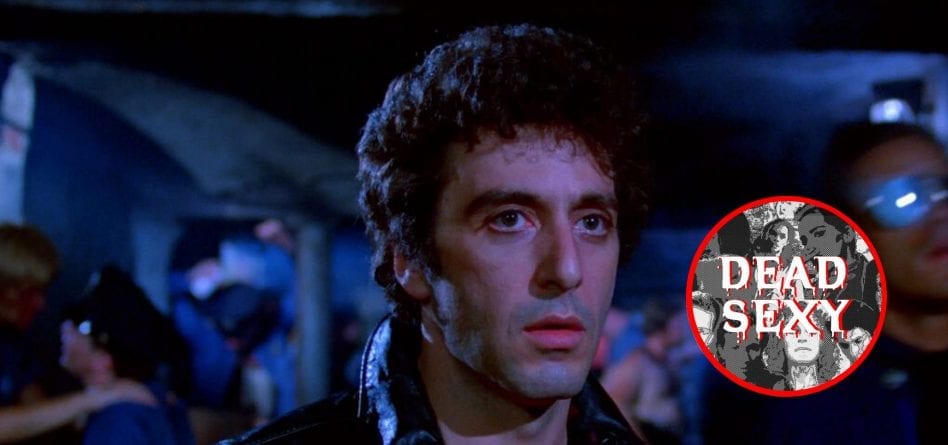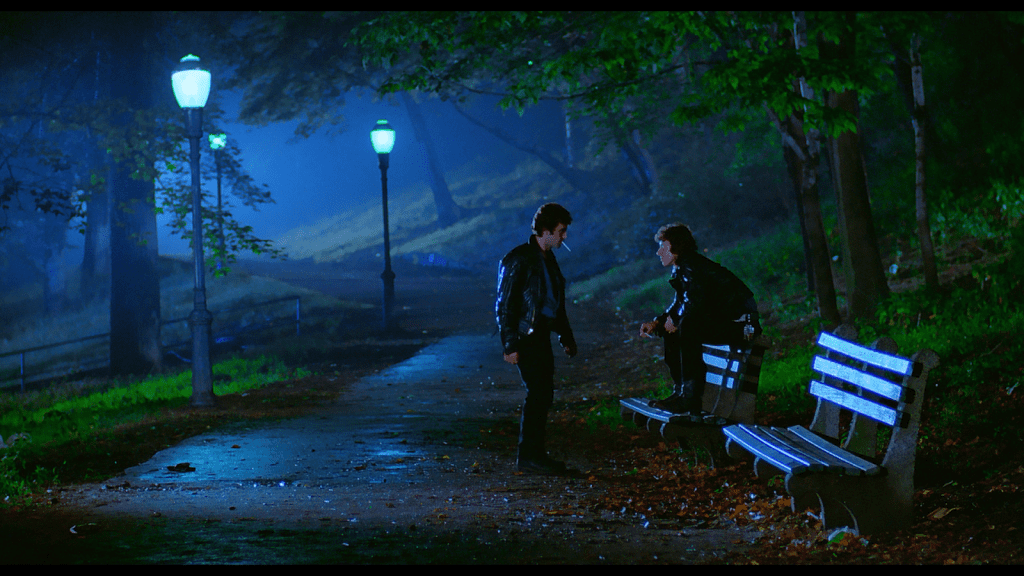Dead Sexy: A Fortnightly Column on Erotic Thrillers
It’s difficult to find an erotic thriller that hasn’t suffered some form of controversy or mockery. Perhaps Cruising, though, is the film to undergo the biggest transformation over the years. Vilified upon release in 1980 by critics, audiences and LGBT communities alike, in recent years it has been reappraised as a piece of masterwork from pioneering director William Friedkin. Part slasher, part mystery, but undeniably an erotic thriller, Cruising is a searing, horrific, stylish piece of cinema—and one of my favourites in the genre.
In New York City, unease is rippling within the (aptly named) Meatpacking district and its gay leather bars. Several men who frequent these spaces are being found brutally murdered in seedy motels, and body parts are turning up in the Hudson River. Because of his physical likeness to the victims, rookie detective Steve Burns (Al Pacino) is recruited to go undercover to these bars to try and pin down the suspected serial killer at large. Inexperienced and overwhelmed, Burns is led down a series of dead ends and into a spiral of internal crises, getting in over his head and becoming disillusioned with the police force and its needless brutality. It’s left deliberately ambiguous as to who the killer is, or if there even is only one killer; Friedkin deliberately messes with the audience by using a different actor to play the murderer throughout the film. Once the suspect has finally been arrested, one more murder takes place, with an inconclusive ending planting enough doubt in the audience’s mind that Burns, himself, is in some way culpable.
By 1980, ‘New Hollywood’ pioneer William Friedkin had experienced a decade of enormous success with The French Connection, The Exorcist and Sorcerer. After several attempts, he was finally persuaded by producer Philip D’Antoni, who had read Gerald Walker’s novel about a serial killer targeting New York City’s gay community, to write a screenplay on the topic. The director also conversed with Randy Jurgensen, a former NYPD detective who went undercover to solve a series of murders taking place after gay men were picked up in leather bars. In a stroke of bizarre coincidence, culprit Paul Bateson had worked on Friedkin’s 1973 film The Exorcist as a technician. Finally, melding those stories with a contemporary mystery where body parts were appearing in the Hudson River, Cruising was born.
There’s no two ways about it: then, and now, Cruising is an incredibly graphic and violent film. Friedkin was forced to cut 40 minutes of footage in order to secure an R rating. Reportedly, he deliberately included extreme ‘distraction material’ he knew the board would demand to cut in the hope of being allowed to keep other material, but repeated demands resulted in over fifty requests of cuts, which cost $50,000. In a 2012 documentary called Interior. Leather Bar., James Franco and Travis Mathews recreate what that explicit footage could have looked like, with the real cut – “the most graphic homosexuality with Pacino watching, and with the intimation that he may have been participating” – rumoured to have been destroyed by United Artists. Sadly, what could have been an insightful documentary in the right hands is a disorganised mess with poor briefing to the cast, an uncomfortable atmosphere and zero concept. But, the idea in itself is a curious one.
Those who discuss Al Pacino’s filmography, especially the articles who recently revisited the actor’s work in honour of his 80th birthday, criminally cast Cruising a side in favour for his showier performances in the The Godfather trilogy, Scarface and Heat. These are excellent performances, sure, and very ‘Pacino’ in their enraged outbursts; but his restrained and slightly awkward leading role in Friedkin’s erotic thriller is a quiet triumph, even if the director later regretting casting him. First on Friedkin’s list was Richard Gere (who, that year, made the American Gigolo instead), believing he could bring an important level of androgyny to the grey-shaded character. But there’s such a subtle, push-and-pull duality to Pacino’s style here that works perfectly for his character. Maybe it was because he was uncomfortable, maybe it’s because he is an excellent actor, maybe it’s because he didn’t quite understand the tone or ambiguities of the script, but none of that matters. In fact, it aids his performance. “If there’s a note that appears to be fear in his performance,” Friedkin stated, “it was there for real. I’ve never worked with an actor who was less prepared.” As Detective Steve Burns, Al Pacino is positively sweaty with fear, discomfort and unspoken titillation; considering his star status at the time of release, his convincing portrayal of the everyman is simply remarkable.
Just like I discussed two weeks ago with Basic Instinct, the filming of Cruising was also affected by gay rights protestors who felt that the film’s plot—a gay leather bar cloaked in murderous depravity—stigmatized them. The film does open with a disclaimer — “This film is not intended as an indictment of the homosexual world. It is set in one small segment of that world, which is not meant to be representative of the whole” — however, this was reportedly demanded by Universal and Motion Picture Association of America, and not included by Friedkin off his own back. One thousand protestors marched against the film, and during filming activists disrupted filming with whistles, mirrors and music. Al Pacino himself understood the protestors, but himself stated that Cruising represented “just a fragment of the gay community, the same way the Mafia is a fragment of Italian-American life.”
And yet, the scenes inside the bars arguably provide a unique glimpse into a queer utopian space, with hundreds of regulars from New York City’s leather bars and S&M communities happily featuring as extras in the clubbing scenes. Filmed in the summer of 1979, Cruising exists in a crucial, ephemeral time: ten years after Stonewall, but just before the AIDS crisis was to cripple, stigmatize and strike fear into these spaces. Friedkin films the bars as seductive, communal and not particularly dangerous, bestowing cinematic beauty to their varied textures: the glint of a glass bottle of poppers, the shine of studs, oily leather tinged with blue light. In one of the more famous scenes, Al Pacino is undercover in the club, in his normal uptight and alert manner. He’s offered a rag soaked with alkyl nitrite, poppers, and after one huff, the club snaps from dull hues into glorious technicolour. He begins to dance: a wild, pumping, dance, as the camera wobbles in ecstasy. It’s an idiosyncrasy that works so well; amid the stigma, the fear, the vilification and the murder, this subcultural tie provides a moment of total euphoria.
Friedkin emphasizes the consensual nature of these spaces and doesn’t brush this subculture with broad strokes. This is a murder mystery and not a documentary, yet considering the nature of the plot and the straightness of the main cast and crew, it’s remarkably tasteful. It’s also profoundly anti-police; scenes in which cops harass streetwalkers and abuse suspects in custody is duly depicted as horrifying, and Pacino’s character verbalizes as such, with the film being more to do with disillusionment with authority figures as opposed to ‘moral corruption’ or the vilification of this gay subculture. Cruising will continue to spark controversy across the critical spectrum. Its position in history, its themes, and its prevailing rebelliousness, though, are certainly worth revisiting.
Part of Dead Sexy: A Fortnightly Column on Erotic Thrillers
Sign up to receive email alerts when a new column is live
Watch Cruising on Amazon or Google Play
Recommended Reading and Watching
Echoes Of Utopia: 40 Years Of ‘Cruising’, The Quietus
A good old-fashioned hit of poppers, The Times Literary Supplement
Interior. Leather Bar., dir. James Franco and Travis Mathews
Making Sense of “Cruising”, The Village Voice
How Cruising exposes the dangers of internalised homophobia, Little White Lies


